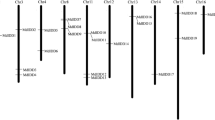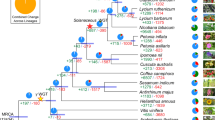Abstract
Flowering is an essential stage of fruit production. To understand the molecular mechanisms controlling flowering in maloid fruit tree species, we isolated and analyzed genes homologous to Arabidopsis LEAFY (LFY; flower meristem identity gene) and TERMINAL FLOWER 1 (TFL1; inflorescence meristem identity gene) from six fruit tree species in the subfamily Maloideae of the Rosaceae; apple (Malus × domestica), Japanese pear (Pyrus pyrifolia), European pear (Pyrus communis), quince (Cydonia oblonga), Chinese quince (Chaenomeles sinensis), and loquat (Eriobotrya japonica). Two LFY homologues and two TFL1 homologues were cloned from all six maloid species by rapid amplification of 3′ and 5′ cDNA ends, reverse transcription-PCR, and PCR with genomic DNA. Phylogenetic analysis by the neighbor-joining method showed that the two LFY homologues and two TFL1 homologues were classified into two distinct clades. The presence of multiple copies of LFY and TFL1 homologues is discussed with reference to the polyploid origin of the subfamily Maloideae.





Similar content being viewed by others
References
Araki T (2001) Transition from vegetative to reproductive phase. Curr Opin Plant Biol 4:63–68
Banfield MJ, Brady RL (2000) The structure of Antirrhinum centroradialis protein (CEN) suggests a role as a kinase regulator. J Mol Biol 297:1159–1170
Battey NH, Tooke F (2002) Molecular control and variation in the floral transition. Curr Opin Plant Biol 5:62–68
Bomblies K, Wang RL, Ambrose BA, Schmidt RJ, Meeley RB, Doebley J (2003) Duplicate FLORICAULA/LEAFY homologs zfl1 and zfl2 control inflorescence architecture and flower patterning in maize. Development 130:2385–2395
Boss PK, Vivier M, Mastumoto S, Dry IB, Thomas MR (2001) A cDNA from grapevine (Vitis vinifera L.), which shows homology to AGAMOUS and SATTERPROOF, is not only expressed in flowers but also throughout berry development. Plant Mol Biol 45:541–553
Bradley D, Carpenter R, Copsey L, Vincent C, Rothstein S, Coen E (1996) Control of inflorescence architecture in Antirrhinum. Nature 379:791–797
Bradley D, Ratcliffe O, Vincent C, Carpenter R, Coen E (1997) Inflorescence commitment and architecture in Arabidopsis. Science 275:80–83
Carmona MJ, Cubas P, Martinez-Zapater JM (2002) VFL, the grapevine FLORICAULA/LEAFY ortholog, is expressed in meristematic regions independently of their fate. Plant Physiol 130:68–77
Challice JS (1974) Rosaceae chemotaxonomy and the origins of the Pomoideae. Bot J Linn Soc 69:239–259
Challice JS (1981) Chemotaxonomic studies in the Rosaceae and the evolutionary origins of the subfamily Maloideae. Preslia 53:289–304
Chevreau E, Lespinasse Y, Gallet M (1985) Inheritance of pollen enzymes and polyploidy origin of apple (Malus × domestica Borkh.). Theor Appl Genet 71:268–277
Coen ES, Romero JM, Doyle S, Elliott R, Murphy G, Carpenter R (1990) Floricaula: a homeotic gene required for flower development in Antirrhinum majus. Cell 63:1311–1322
Corbit KC, Trakul N, Eves EM, Diaz B, Marshall M, Rosner MR (2003) Activation of Raf-1 signaling by protein kinase C through a mechanism involving Raf kinase inhibitory protein. J Biol Chem 278:13061–13068
Doyle JJ, Doyle JL (1987) A rapid DNA isolation procedure from small quantities of fresh leaf tissues. Phytochem Bull 19:11–15
Evans RC, Campbell CS (2002) The origin of the apple subfamily (Maloideae; Rosaceae) is clarified by DNA sequence data from duplicated GBSSI genes. Am J Bot 89:1478–1484
Foucher F, Morin J, Courtiade J, Cadioux S, Ellis N, Banfield MJ, Rameau C (2003) DETERMINATE and LATE FLOWERING are two TERMINAL FLOWER 1/CENTRORADIALIS homologs that control two distinct phases of flowering initiation and development in pea. Plant Cell 15:2742–2754
Frohlich MW, Meyerowitz EM (1997) The search for flower homeotic gene homologs in basal angiosperms and gnetales: a potential new source of data on the evolutionary origin of flowers. Int J Plant Sci 158:S131–S142
Jeong DH, Sung SK, An G (1999) Molecular cloning and characterization of CONSTANS-like cDNA clones of the fuji apple. J Plant Biol 42:23–31
Kelly AJ, Bonnlander MB, Meeks-Wagner DR (1995) NFL, the tobacco homolog of FLORICAULA and LEAFY, is transcriptionally expressed in both vegetative and floral meristems. Plant Cell 7:225–234
Kotoda N, Wada M, Komori S, Kidou S, Abe K, Masuda T, Soejima J (2000) Expression pattern of homologues of floral meristem identity genes LFY and AP1 during flower development in apple. J Am Soc Hortic Sci 125:398–403
Kotoda N, Wada M, Kusaba S, Kano-Murakami Y, Masuda T, Soejima J (2002) Overexpression of MdMADS5, an APETALA1-like gene of apple, causes early flowering in transgenic Arabidopsis. Plant Sci 162:679–687
Kyozuka J, Konishi S, Nemoto K, Izawa T, Shimamoto K (1998) Down-regulation of RFL, the FLO/LFY homolog of rice, accompanied with panicle branch initiation. Proc Natl Acad Sci USA 95:1979–1982
Liljegren SJ, Gustafson-Brown C, Pinyopich A, Ditta GS, Yanofsky MF (1999) Interaction among APETALA1, LEAFY, and TERMINAL FLOWER 1 specify meristem fate. Plant Cell 11:1007–1018
Molinero-Rosales N, Jamilena M, Zurita S, Gomez P, Capel J, Lozano R (1999) FALSIFLORA, the tomato orthologue of FLORICAULA and LEAFY, controls flowering time and floral meristem identity. Plant J 20:685–693
Parcy F, Nilsson O, Busch MA, Lee I, Weigel D (1998) A genetic framework for floral patterning. Nature 395:561–566
Pena L, Martin-Trillo M, Juarez J, Pina JA, Navarro L, Martinez-Zapater JM (2001) Constitutive expression of Arabidopsis LEAFY or APETALA1 genes in citrus reduces their generation time. Nat Biotechnol 19:263–267
Phipps JB, Robertson KR, Rohrer JR, Smith PG (1991) Origins and evolution of subfam. Maloideae (Rosaceae). Syst Bot 16:303–332
Pnueli L, Carmel-Goren L, Hareven D, Gutfinger T, Alvarez J, Ganal M, Zamir D, Lifschitz E (1998) The SELF-PRUNING gene of tomato regulates vegetative to reproductive switching of sympodial meristems and is the ortholog of CEN and TFL1. Development 125:1979–1989
Pnueli L, Gutfinger T, Hareven D, Ben-Naim O, Ron N, Adir N, Lifschitz E (2001) Tomato SP-interacting proteins define a conserved signaling system that regulates shoot architecture and flowering. Plant Cell 13:2687–2702
Ratcliffe OJ, Bradley DJ, Coen ES (1999) Separation of shoot and floral identity in Arabidopsis. Development 126:1109–1120
Rowland LJ, Nguyen B (1993) Use of polyethylene glycol for purification of DNA from leaf tissue of woody plants. Biotechniques 14:734–736
Saitou N, Nei M (1987) The neighbor-joining method—a new method for reconstructing phylogenetic trees. Mol Biol Evol 4:406–425
Sax K (1933) The origin of the Pomoideae. Proc Am Soc Hortic Sci 30:147–150
Shannon S, Meeks-Wagner DR (1991) A mutation in the Arabidopsis TFL1 gene affects inflorescence meristem development. Plant Cell 3:877–892
Sung SK, Yu GH, An G (1999) Characterization of MdMADS2, a member of the SQUAMOSA subfamily of genes, in apple. Plant Physiol 120:969–978
Sung SK, Yu GH, Nam J, Jeong DH, An G (2000) Developmentally regulated expression of two MADS-box genes, MdMADS3 and MdMADS4, in the morphogenesis of flower buds and fruits in apple. Planta 210:519–528
Thompson JD, Gibson TJ, Plewniak F, Jeanmougin F, Higgins DG (1997) The ClustalX windows interface: flexible strategies for multiple sequence alignment aided by quality analysis tools. Nucleic Acids Res 25:4876–4882
Wada M, Cao Q, Kotoda N, Soejima J, Masuda T (2002) Apple has two orthologues of FLORICAULA/LEAFY involved in flowering. Plant Mol Biol 49:567–577
Walton EF, Podivinsky E, Wu R (2001) Bimodal patterns of floral gene expression over the two seasons that kiwifruit flowers develop. Physiol Plant 111:396–404
Weeden N, Lamb R (1987) Genetics and linkage analysis of 19 isozyme loci in apple. J Am Soc Hortic Sci 112:865–872
Weigel D, Nilsson O (1995) A developmental switch sufficient for flower initiation in diverse plants. Nature 377:495–500
Weigel D, Alvarez J, Smyth DR, Yanofsky MF, Meyerowitz EM (1992) LEAFY controls floral meristem identity in Arabidopsis. Cell 69:843–859
Westwood MN (1978) Flowering. In: Westwood MN (ed) Temperate-zone pomology. Freeman, New York, pp 171–172
Acknowledgements
This work was supported by a Grant-in-Aid (no. 14656014) for Exploratory Research to R.T. from the Japan Society for the Promotion of Science. We gratefully acknowledge the gift of plant material from K. Banno and T. Minemura of Shinshu University (Nagano, Japan).
Author information
Authors and Affiliations
Corresponding author
Additional information
The nucleotide sequence data reported here are available in the DDBJ/EMBL/GenBank database under the accession numbers AB162028 (AFL1-fuji), AB162029 (PpLFY-1), AB162030 (PcLFY-1), AB162031 (CoLFY-1), AB162032 (CsLFY-1), AB162033 (EjLFY-1), AB162034 (AFL2-Fuji), AB162035 (PpLFY-2), AB162036 (PcLFY-2), AB162037 (CoLFY-2), AB162038 (CsLFY-2), AB162039 (EjLFY-2), AB162040 (MdTFL1-1), AB162041 (PpTFL1-1), AB162042 (PcTFL1-1), AB162043 (CoTFL1-1), AB162044 (CsTFL1-1), AB162045 (EjTFL1-1), AB162046 (MdTFL1-2), AB162047 (PpTFL1-2), AB162048 (PcTFL1-2), AB162049 (CoTFL1-2), AB162050 (CsTFL1-2), AB162051 (EjTFL1-2).
Rights and permissions
About this article
Cite this article
Esumi, T., Tao, R. & Yonemori, K. Isolation of LEAFY and TERMINAL FLOWER 1 homologues from six fruit tree species in the subfamily Maloideae of the Rosaceae. Sex Plant Reprod 17, 277–287 (2005). https://doi.org/10.1007/s00497-004-0239-3
Received:
Accepted:
Published:
Issue Date:
DOI: https://doi.org/10.1007/s00497-004-0239-3




